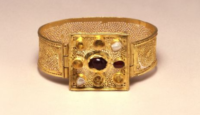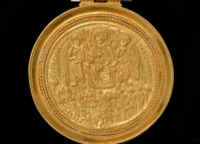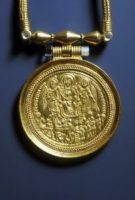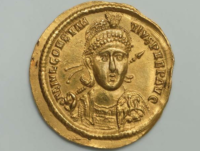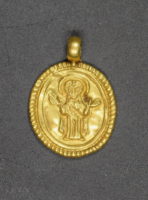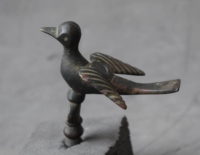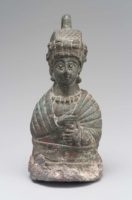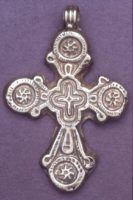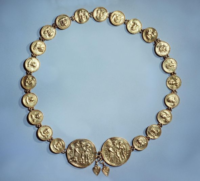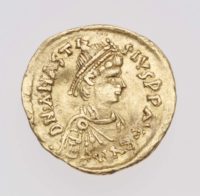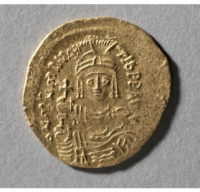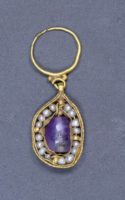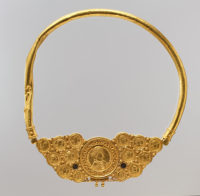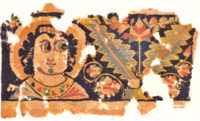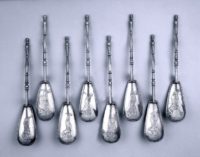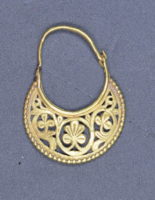Bracelet with Jewelled Clasp, Period: Early Byzantine, Date: -circa-Second half 4th Century (possibly 360-80). Materials: gold and gems. The museum is open to the public Tuesday through Sunday, 11:30 a.m.–5:30 p.m., except for federal holidays.
Enkolpion with Enthroned Virgin, Nativity, Adoration and Baptism, Period: Early Byzantine, circa: Last quarter 6th century (ca. 583). Materials: gold. The museum is open to the public Tuesday through Sunday, 11:30 a.m.–5:30 p.m., except for federal holidays.
Enkolpion with Enthroned Virgin, Nativity, Adoration; and Baptism. Period: Early Byzantine Last quarter 6th century (ca. 583). Materials: gold. The museum is open to the public Tuesday through Sunday, 11:30 a.m.–5:30 p.m., except for federal holidays
Solidus of Constantius II (333–361). Material: Gold. The museum is open to the public Tuesday through Sunday, 11:30 a.m.–5:30 p.m., except for federal holidays.
Gold Oval Pendant; embossed with a figure of the Virgin standing in the attitude of an orans within a pearled border. Findspot: Nile Delta, Alexandria, Egypt. Period: Early Byzantine. British Museum is closed 24, 25 and 26 December and 1 January, but is open every other day of the year. Fast facts about the British Museum: Founded: 1753, Collection size: 8 million objects, Oldest object in the collection: Stone chopping tool (nearly 2 million years old).
Ivory Panel, Period: Early Byzantine, circa: 6th c. Made in: Syria. Dimensions: Height: 16.3 centimetres Width: 8.1 centimetres Depth: 1 centimetres Weight: 128 grammes. Carved in relief with a depiction of The Baptism: young Christ standing full face up to waist in water; to left, St John the Baptist stands leaning forward upon a rock, one hand resting upon Christ’s head. British Museum is closed 24, 25 and 26 December and 1 January, but is open every other day of the year. Fast facts about the British Museum: Founded: 1753, Collection size: 8 million objects, Oldest object in the collection: Stone chopping tool (nearly 2 million years old).
Ornament (Gammadion and Segmentum) from a Tunic, Period: Early Byzantine; circa: 6th century. Materials: tabby ground, inwoven tapestry ornament; wool. The Cleveland Art Museum Hours: Tuesdays, Thursdays, Saturdays, Sundays 10:00 a.m.–5:00 p.m. Wednesdays, Fridays 10:00 a.m.–9:00 p.m. Closed Mondays.
Bird Figure, Period: Early Byzantine, circa: 6thC-7thC; Made in: Egypt. Dimensions: Height: 2.6 inches. British Museum is closed 24, 25 and 26 December and 1 January, but is open every other day of the year. Fast facts about the British Museum: Founded: 1753, Collection size: 8 million objects, Oldest object in the collection: Stone chopping tool (nearly 2 million years old).
Steelyard weight in the form of a bust of an empress, Period: Early Byzantine Period, circa: 5th century A.D. Material: Bronze. The MFA is open 7 days a week. Monday and Tuesday 10 am–5 pm, Wednesday–Friday 10 am–10 pm, Saturday and Sunday 10 am–5 pm.
Pendant Cross, Period: Early Byzantine (7thc.) Height: 55.8 millimetres Width: 37.2 millimetres Depth: 7 millimetres Weight: 7.27 grammes. Materials: Gold. British Museum is closed 24, 25 and 26 December and 1 January, but is open every other day of the year. Fast facts about the British Museum: Founded: 1753, Collection size: 8 million objects, Oldest object in the collection: Stone chopping tool (nearly 2 million years old).
Marriage Belt, Period: Early Byzantine, circa Late 6th-to-early 7th century A.D. Material: Gold. The museum is open to the public Tuesday through Sunday, 11:30 a.m.–5:30 p.m., except for federal holidays.
Tremissis of Anastasius I, Gold, Period: Early Byzantine, circa: A.D. 491–518. Mint: Constantinople. The MFA is open 7 days a week. Monday and Tuesday 10 am–5 pm, Wednesday–Friday 10 am–10 pm, Saturday and Sunday 10 am–5 pm.
Gold Finger Ring, Period: Early Byzantine (6 th. c.) flat hoop cut into eight alternating circular and hexagonal panels; circular panels engraved alternately with dove and palmette; hexagonal panels with S-shaped line crossed by bar, lines terminating with punched dots. Found/Acquired: Beirut. British Museum is closed 24, 25 and 26 December and 1 January, but is open every other day of the year. Fast facts about the British Museum: Founded: 1753, Collection size: 8 million objects, Oldest object in the collection: Stone chopping tool (nearly 2 million years old).
Solidus of Maurice Tiberius, 583-602, Material: gold, Diameter: w. 2.2 cm (13/16 in.). The Cleveland Art Museum Hours: Tuesdays, Thursdays, Saturdays, Sundays 10:00 a.m.–5:00 p.m. Wednesdays, Fridays 10:00 a.m.–9:00 p.m. Closed Mondays.
Earring; Period: Early Byzantine; circa: 6thC-7thC; Made in: Tharros. Materials: gold; with pearl and amethyst. Dimensions: Length: 35 millimetres. British Museum is closed 24, 25 and 26 December and 1 January, but is open every other day of the year. Fast facts about the British Museum: Founded: 1753, Collection size: 8 million objects, Oldest object in the collection: Stone chopping tool (nearly 2 million years old).
Pectoral with Coins and Pseudo-Medallion, Period: Early Byzantine, circa: 539–50, Materials: Gold, niello, On view at The Met Fifth Avenue in Gallery 302. The Metropolitan Museum of Art (New York) is one of the world’s largest and finest art museums. Its collection includes more than two million works of art spanning five thousand years of world culture, from prehistory to the present and from every part of the globe. Public Hours: 10:30 a.m.–5:30 p.m. Open seven days a week.
Three sections of a Gold necklace. Materials: sapphires, emeralds, cornelians and pearls. Period: Early Byzantine; circa: 5th c. Made in: Alexandria, Egypt. Their height varies from 0.05 to 0.06 m. The Benaki Museum of Greek Culture is housed in one of the most beautiful neoclassical-style buildings in Athens, near the National Garden and the Hellenic Parliament.
Tapestry fragment Egyptian (Coptic), Period: Early Byzantine, circa: 5th-6th century A.D. Material: silk. The MFA is open 7 days a week. Monday and Tuesday 10 am–5 pm, Wednesday–Friday 10 am–10 pm, Saturday and Sunday 10 am–5 pm.
Silver spoon, Period: Early Byzantine; 650 (circa). Found: Acheripoetos Monastery, monastery (near)(Europe,Cyprus,Nicosia (district),Kyrenia,Acheripoetos Monastery) British Museum is closed 24, 25 and 26 December and 1 January, but is open every other day of the year. Fast facts about the British Museum: Founded: 1753, Collection size: 8 million objects, Oldest object in the collection: Stone chopping tool (nearly 2 million years old).
Gold Earring; Period: Early Byzantine (6thc-7thc), one of a pair crescent-shaped loop. Found: Lambousa (Cyprus). British Museum is closed 24, 25 and 26 December and 1 January, but is open every other day of the year.


